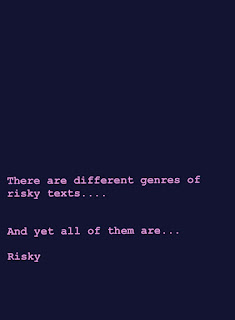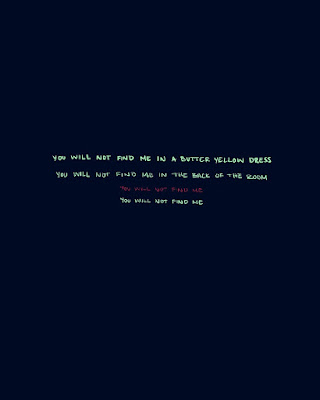🟩Start, 🟨breathe, 🟥stop.
Much like punctuation in a sentence, color aids humans in the way we conceptualize ideas. Whether in a sentence or in a composition (window, canvas, what have you), these visual cues are the fulcrum upon which comprehension and confusion are balanced. They are the tour guides of knowledge; for they do not tell you what to think, nor what the "answer" is, but they will give you confidence on a vulnerable road. Well, how do they help? They say, "stop," "start," and "breathe," so you are not overwhelmed when approaching something new. This is true in life, too: it's harder to do something all at once than to break it up into smaller tasks. You would not pour an entire glass of water down your throat without swallowing... you would choke! If composition is the grammar of visual art, then placement of color may be the punctuation, as if framed by capitals and periods. Both box everything up for your lil human mind to grasp on to; organizational tools, if you will, to help facilitate the the comprehension of a new idea as a means of controlling your reality.
Each medium, is simply a new language. I mean, I believe in the power of literature, but there are many ways to absorb knowledge. Humans do not just learn through books, or even words. The oft-misunderstood process of learning is multifaceted because knowledge is not limited to form. Learning happens whether we realize it or not. Our ability to share knowledge is what makes us so... limitless. An urban planner makes a certain kind of line on the road and a certain kind of sign the same shade of yellow, because there is a system of meaning put in place by using color as a way to code behavior. In other words, we have a general understanding of yellow as an instruction to use caution when used to direct traffic. It says, "chill the fuck out," "be careful," take a breath.
Punctuation is similar. Surely, it's easy to get confused when the brain cannot focus on one idea at a time in a run-on sentence. Well-used punctuation guides readers through complex ideas, just as yellow guides cars and pedestrians down a crowded street. Capital letters code where to begin, and which words have more meaning or specificity than others, even when the spelling is the same. God as the singular, omnipresent guiding force is not to be confused with "god," the title to a person for their extraordinary power or ability.
Commas tell us where ideas get a little too complex to fit into a singular subject-verb-object pairing (the bones of the sentence). With all the adjectives, prepositions, conjunctions, and adverbs we add to our phrases (the muscle and flesh between commas), it's easy to get lost. Periods, on the other hand, are definitive and confident endings. Period says, "the end." This is why when we say "period" as a colloquialism, it's actually pretty on-point. -- Get it? On point? -- It has the same effect of "that's that on that," or "that's it, the end." Imagine writing those words on the end of every idea, but then continuing to write. And write. And write. What a fucking chore, amirite? Well, you get the point. (Got you again, hahh.) Thus, punctuation is just as key to clarity as the words themselves. Just as colors and shapes are to a composition. They all create intention; whether that is for feeling or for practicality is up to the creator.
Color! This is the part you're curious about isn't it? I suspect you may have anticipated what I'd say about punctuation. But, color though! People love color. How could you not? Color is feeling, it's soul. It's a psychological, emotional reaction. We understand that one version of blue looks like the sky and another like the ocean. We know that grass is not the same green as pine tree needles. We understand there is not just green, or just blue. Color is more about perception than truth. It seems like a fact, but it is not.
One person's teal is not the next person's teal. Less commonly observable colors are usually made by humans, or they do not occur in common nature. Some have specific connotations depending on our experiences. If I had lilac sheets in my room as a kid that were slightly more pink than they were purple, and maybe just a bit darker than my friend's lilac pencil case that she had in third grade, maybe when she sees my sheets for the first time at a sleepover 10 years later we will argue over if they're really lilac or not. Maybe she'll think it reminds her more of a color she often sees at sunset, or on a flower. Do you know what I mean? We experience color, we don't create it. Humans are merely translators. But that's another conversation.
Humans cluster similar colors together into "families" to make sense of and recognize them in different environments. I'll explain. Look up. Pick a color that you can see. The only rule is that you cannot choose black, white, or gray. These are not colors, they're shades and are not important to this exercise. Pure shades don't really exist in nature. There are certainly exceptions, but as long as there is light, neither black nor white really exist. (Ignore charcoal, that's a chemical reaction, like neon... there's a footnote at the bottom for this if you wanna know).*
Let's say you picked blue. Focus on it. Visualize yourself zooming out so that instead of looking at points in the room around you, you can see everything that fits within your perspective. Now think about blue. Spot that thing across from you that's primary blue, the tiny blue light from a device, the lid on a container. Do you see how that color is speckled throughout your field of view? Your eyelids frame your vision, just as the edge of an image would, too.
This is why it is so difficult to translate what is seen into something else that is supposed to be looked at. -- But we could get real meta there, too: I mean, if everything we see in modern society is constructed by humankind for other humans, then isn't everything meant to be seen? I believe that even the most functional of designers want to make things that are easy to look at. Or, maybe they want to make it "ugly" or difficult to look at on purpose. That's a different kind of beauty, and it's still very intentional even if the purpose is to actually make you look away and possibly even question why you looked away. Like the visual renderings of monsters - manifestations of our fears and insecurities as human beings. Either way, there's an intent to control your gaze as their student.
Does an architect not "see" a room first in the mind and draw it just as a contractor looks at a drawing of that very room on the page and builds it? It's really about the intention, nor from whom or whence it came. Was it God's intention? The universe? Human-kind? -- The story of perception and understanding is fraught with "what ifs." Don't worry about it, boo. Sometimes, you've got to stop your mind from eating at everything it encounters. Period. (LOL.) Everything around us is imbued with meaning whether we recognize it or not.
Colors and symbols (punctuation) mark up the world around us. Now, they are even combined, as we derive new ways to make communication easier. Even with all of the guides, the instructions, the how-tos we devise, misunderstanding still occurs. Our plight to control outcomes through language is ancient. Perception is a motherfucker. We lay the things we already know on top of what we see before us and interpret them our own way. Because we are not the same, we do not see the same.
___
*On earth, heat burns things and makes them black. I associate black and white with things that are dead. The black and white items you see around you are made of synthetic materials like plastic. Glass is tricky, because it's just melted sand, but it becomes transparent. Glass usually gives off bluer and greener tones, though, it's just less visible to the naked eye in thinner pieces of glass like windows and mirrors. Usually when glass has a color it's because other compounds are introduced like Cadmium Sulfide or Cobalt Oxide (hence, Cadmium Yellow and Cobalt Blue, paint and dye colors). So just like blowing glass into different colors, every time a painter lays down paint, they are really just mixing chemicals. Whereas, when you see a shadow, you see the absence of light on a certain object when another object is in front of it













